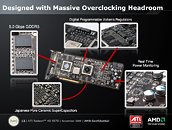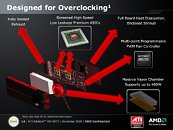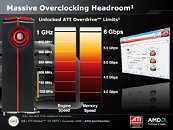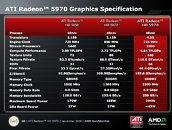Monday, November 16th 2009

Radeon HD 5970 Offers Massive Overclocking Headroom
AMD's dual-GPU flagship graphics accelerator, the Radeon HD 5970, is closer than you think it is. Slated for 18th Nov, it includes every feature that allows AMD to reclaim the performance leadership it yearned for since the beginning of this year. In a series of company slides sourced from XtremeSystems Forums, it is learned that this could be one of the first accelerators which AMD "openly" markets as having a "Massive Headroom" for overclocking. While the clock speeds on the HD 5970 are lower than those on the single-GPU HD 5870, AMD lifted limits on what the driver-level ATI Overdrive software can offer in terms of clock speeds. While the engine (core) and memory speeds are set at 720/1000 MHz, the unlocked ATI Overdrive lets users take the clock speeds all the way up to 1000/1500 MHz. That's 30% for the core, and a stellar 50% for the memory.
To back such speeds, AMD seems to have splurged heavily on top-notch components on the PCB. To begin with, the PCB holds two high-grade AMD Cypress GPUs, each with all its 1600 stream processors enabled. The GDDR5 memory, while clocked at 1000 MHz or 4 GT/s, is technically rated by its manufacturer to run at 1250 MHz or 5 GT/s. All systems are powered by high-grade digital PWM voltage regulators, with independent Volterra VRM controllers that allow real-time monitoring, and software voltage control. Barring the five-odd cylindrical solid-state capacitors, Japanese pure ceramic surface-mount capacitors are extensively made use of.The card's cooling assembly isn't any less descriptive either. It consists of a back-plate that cools memory chips on the reverse side of the PCB, while its obverse side is cooled by a large, consistent vapor-chamber plate, which covers the main components such as GPUs, the PCI-Express bridge chip, and the VRM chips. This is a design change compared to the R700 and R680, in which each GPU had its own heatsink, and one of the two would end up with second-hand (pre-heated) air from the other. Instead, the vapor-chamber plate conveys heat directly to a large, monolithic heatsink, which from the looks of it, features aluminum-fabbed air-channels. AMD's workhorse leaf-blower is still around, though this time, it is controlled by an SMSC EMC-2103 multi-point programmable PWM fan controller. The specs sheet shows the card's idle and maximum board power draws to be 42W and 294W, respectively.
Source:
XtremeSystems Forums
To back such speeds, AMD seems to have splurged heavily on top-notch components on the PCB. To begin with, the PCB holds two high-grade AMD Cypress GPUs, each with all its 1600 stream processors enabled. The GDDR5 memory, while clocked at 1000 MHz or 4 GT/s, is technically rated by its manufacturer to run at 1250 MHz or 5 GT/s. All systems are powered by high-grade digital PWM voltage regulators, with independent Volterra VRM controllers that allow real-time monitoring, and software voltage control. Barring the five-odd cylindrical solid-state capacitors, Japanese pure ceramic surface-mount capacitors are extensively made use of.The card's cooling assembly isn't any less descriptive either. It consists of a back-plate that cools memory chips on the reverse side of the PCB, while its obverse side is cooled by a large, consistent vapor-chamber plate, which covers the main components such as GPUs, the PCI-Express bridge chip, and the VRM chips. This is a design change compared to the R700 and R680, in which each GPU had its own heatsink, and one of the two would end up with second-hand (pre-heated) air from the other. Instead, the vapor-chamber plate conveys heat directly to a large, monolithic heatsink, which from the looks of it, features aluminum-fabbed air-channels. AMD's workhorse leaf-blower is still around, though this time, it is controlled by an SMSC EMC-2103 multi-point programmable PWM fan controller. The specs sheet shows the card's idle and maximum board power draws to be 42W and 294W, respectively.




90 Comments on Radeon HD 5970 Offers Massive Overclocking Headroom
I haven't heard of ANY high end card with such high percentage OCs EVER. Could it be that they don't want to invest in a better cooler (could be way expensive), so they are essentially selling an undercooled, underclocked version for people to tinker with as they please?
EDIT: Looks like not if the cooling beast on it is rated for 400W.
Maybe the Overdrive has just been opened up a little for their uber high end, but still it looks good just from that.
forums.techpowerup.com/showpost.php?p=1638260&postcount=114
Alright then, we'll change it to 'monumentally staggering'. ;)
It's the 7th pic found in the link i posted earlier, from jaredpace.
Maybe they clocked it lower to let those who do overclock them get a better 3rd party cooler which would be more suitable.
Still thinking of waiting till the 68xx range.
All they're really saying is, you can bring it there with overdrive, not that it will.
Either way, I hope the vaper cooler works a lot better than what they have used with the 4870x2 and 3870x2. I know everyone always rants about Sapphire's vapor cards, but this will really prove the tech in case anyone had any doubts.Better get to it! You only got 2 days until it is released!! :laugh:
That said, temp monitoring and voltage tweaks in Overdrive = Massive win for ATi in the enthusiast market.
While I understand they wish to avoid warranty issues and whatnot, I feel this should be an added feature of XT chips. As they pointed out in the slides, these things are now being binned for high and low clock speed potential. When you think about it, there's no point in slapping a potential high-end chip on a lower-grade product when it is likely not to be overclocked by its owner. Conversely, if your high-grade products contain only the higher-grade chips, the public are more likely to get larger overclocks and thus you get larger publicity where it really matters. This could really do a lot for their reputation if they were to roll it out throughout their product lineup...Well no kidding, but you could say that for any product from any manufacturer. In fact they're blatantly requiring that AIBs use memory rated much higher than they intend to clock it. There is nothing wrong with this, especially given the ease with which the average user can overclock these things.
Will this be released at the same time as Cat's 9.11?